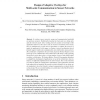362 search results - page 43 / 73 » Separation principles in wireless networking |
JMM
2007
13 years 8 months ago
2007
Spontaneous interaction in wireless ad-hoc networks is often desirable not only between users or devices in direct contact, but also with devices that are accessible only via a wi...
DCOSS
2005
Springer
14 years 2 months ago
2005
Springer
In wireless sensor networks, energy and communication bandwidth are precious resources. Traditionally, layering has been used as a design principle for network stacks; hence routin...
AINA
2005
IEEE
14 years 2 months ago
2005
IEEE
: The pervasive nature of mobile and wireless systems has led to increased concerns over Quality of Service (QoS). In the prevailing models for QoS management, QoS resolution is ac...
DEXA
2010
Springer
13 years 9 months ago
2010
Springer
Given a spatio-temporal network (ST network) whose edge properties vary with time, a time-sub-interval minimum spanning tree (TSMST) is a collection of distinct minimum spanning t...
RTSS
2003
IEEE
14 years 1 months ago
2003
IEEE
Preventing denial-of-service attacks in wireless sensor networks is difficult primarily because of the limited resources available to network nodes and the ease with which attacks...

